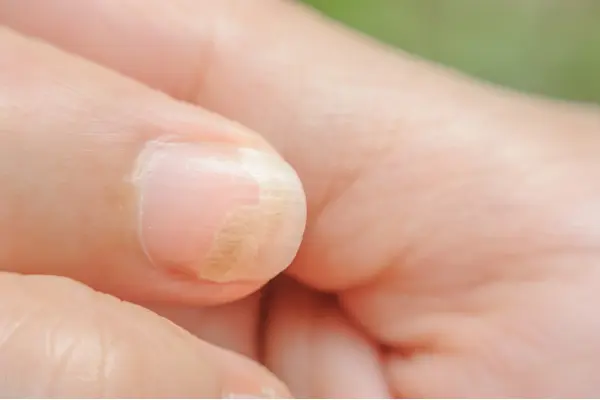Nail psoriasis – what causes it and how to treat it?


Nail psoriasis is a nail disease that occurs as part of skin psoriasis or psoriatic arthritis (PsA). Psoriasis can manifest as a nail disease on the hands or a nail disease on the feet, most commonly through onycholysis. Nail psoriasis is an incurable disease; however, implementing the proper steps can significantly reduce its symptoms, allowing for a return to normal functioning.
What is the course of nail psoriasis? What are the causes of this condition? And finally – how does it manifest, and how can it be treated to prevent it from interfering with daily life? Read on to find out!
Nail psoriasis – the most common causes and symptoms
What causes the development of nail psoriasis on the hands or feet? We can divide these causes into genetic and environmental factors.
What circumstances and conditions promote the development of nail psoriasis? The most common ones are:
- various infections
- use of certain medications or sudden withdrawal of corticosteroids (anti-inflammatory, antiallergic, and immunosuppressive agents)
- pregnancy
- substance abuse
- excessive stress
- hypercalcemia (excess calcium in the body), use of certain ointments for the skin
- untreated tooth decay
How to identify nail psoriasis? What are its symptoms?
Nail psoriasis can occur in both children and adults. Symptoms of this nail disease include mild symptoms and those that can significantly impact the quality of life.
What are the most common symptoms of nail psoriasis?
- Pitting – the most common and quickly recognizable symptom of nail psoriasis. These are tiny indentations on the nail plate, more frequently observed in nail psoriasis on the hands.
- Onycholysis – separation of the nail from its bed. This can lead to the growth of microorganisms, contributing directly to the development of nail psoriasis.
- Onychodystrophy – thinning of the nail plate caused by excessive fragility.
- Oil spots – visible changes on the nail plate resulting from psoriasis lesions. Their characteristic yellowish color can identify them.
- Linear changes – damage to the matrix leading to lines across the nail. This can cause the nail plate to separate from the nail fold in severe cases.
Check out: Green bacteria on the nail – how to treat It? What is Pseudomonas aeruginosa?

Nail psoriasis: home remedies – do they work?
As with any disease, nail psoriasis should be consulted with a doctor. However, home remedies can also be used alongside creams or ointments.
What home remedies can support the treatment of nail psoriasis?
- Urea-based ointments or creams – their strong moisturizing properties help retain water and provide longer-lasting hydration than traditional ointments. They help care for dry skin, a common symptom of psoriasis.
At Silcare, you’ll find several urea creams in various concentrations. Please choose the best option for you and use it in multiple ways to ensure proper hydration for your body and nails! - Vitamin A or Vitamin D3 ointments – two inexpensive pharmacy products that can be extremely helpful against nail psoriasis, fungal infections, or other nail diseases.
Vitamin A effectively soothes irritated areas and speeds up skin regeneration. Vitamin D3, on the other hand, moisturizes while gently exfoliating. Noticeable improvements, especially in external symptoms, can often be seen within days of use. - Salicylic acid – a simple, yet excellent household remedy for calming inflammation without irritating, making it suitable for all skin types.
- Zinc ointment – zinc can significantly promote skin regeneration, starting visible improvements within weeks.
How to treat nail psoriasis?
Is it possible to completely cure psoriasis, such as nail psoriasis? Unfortunately, no, but by following medical recommendations, we can significantly reduce its symptoms, improving quality of life.
How is nail psoriasis treated? Steroid medications, specifically corticosteroids, are often used. Other effective methods for alleviating symptoms include injections, LED light therapy adapted to the condition, ointments with acids and vitamins, and, in severe cases, biological pharmacological treatments.
Skin and nail care are crucial in nail psoriasis therapy. Consistent care prevents further damage to nails and skin.
Check out our series of guides on nail diseases to learn how we can help you solve your problem!
Recommended






